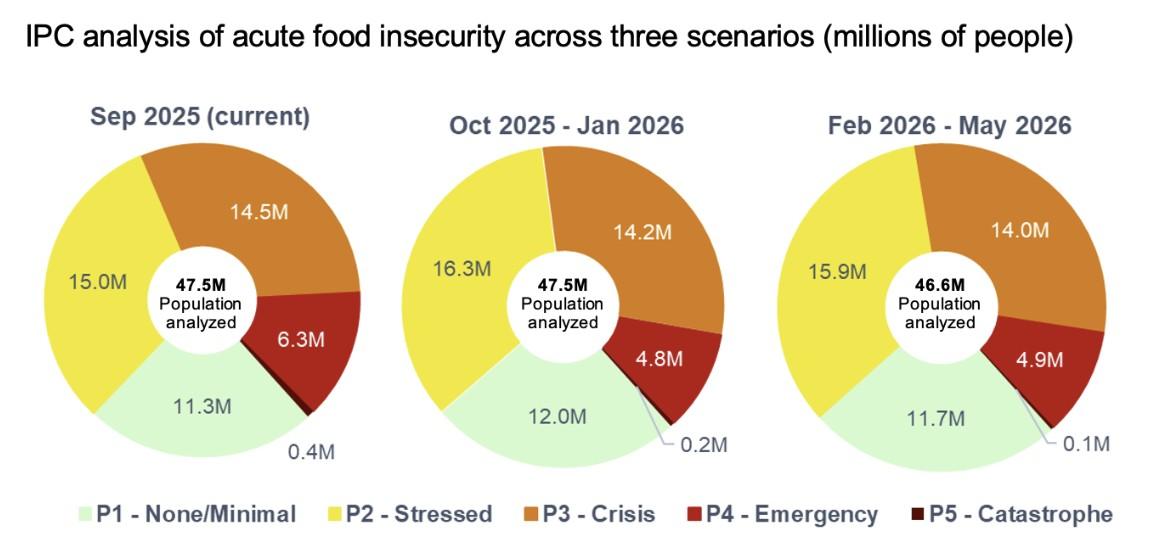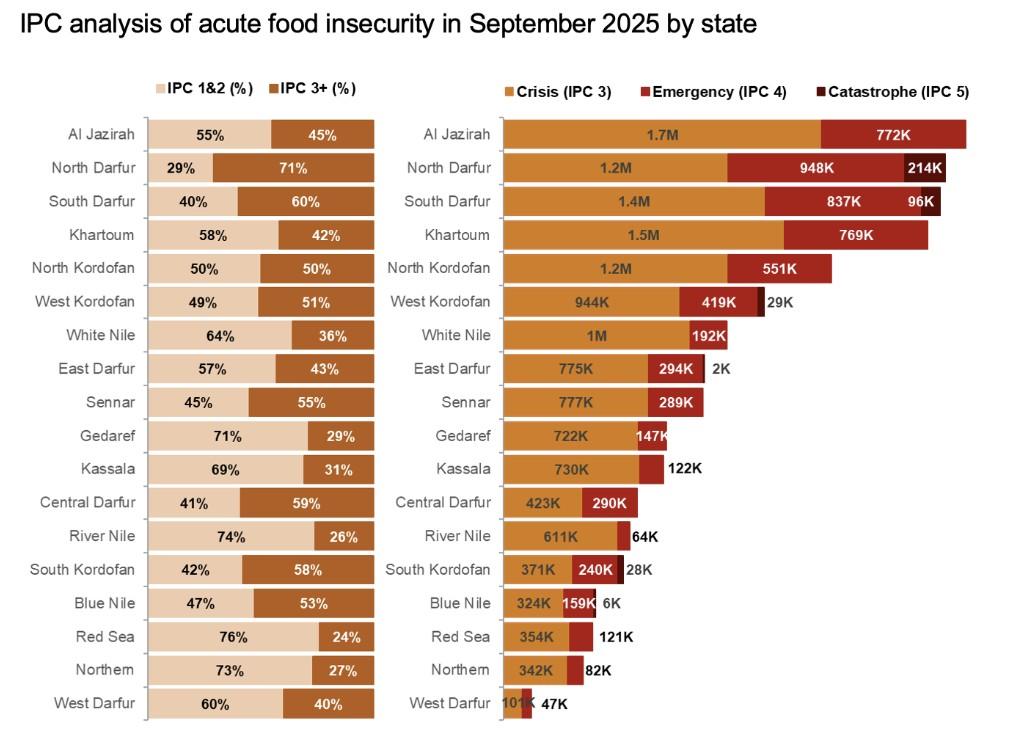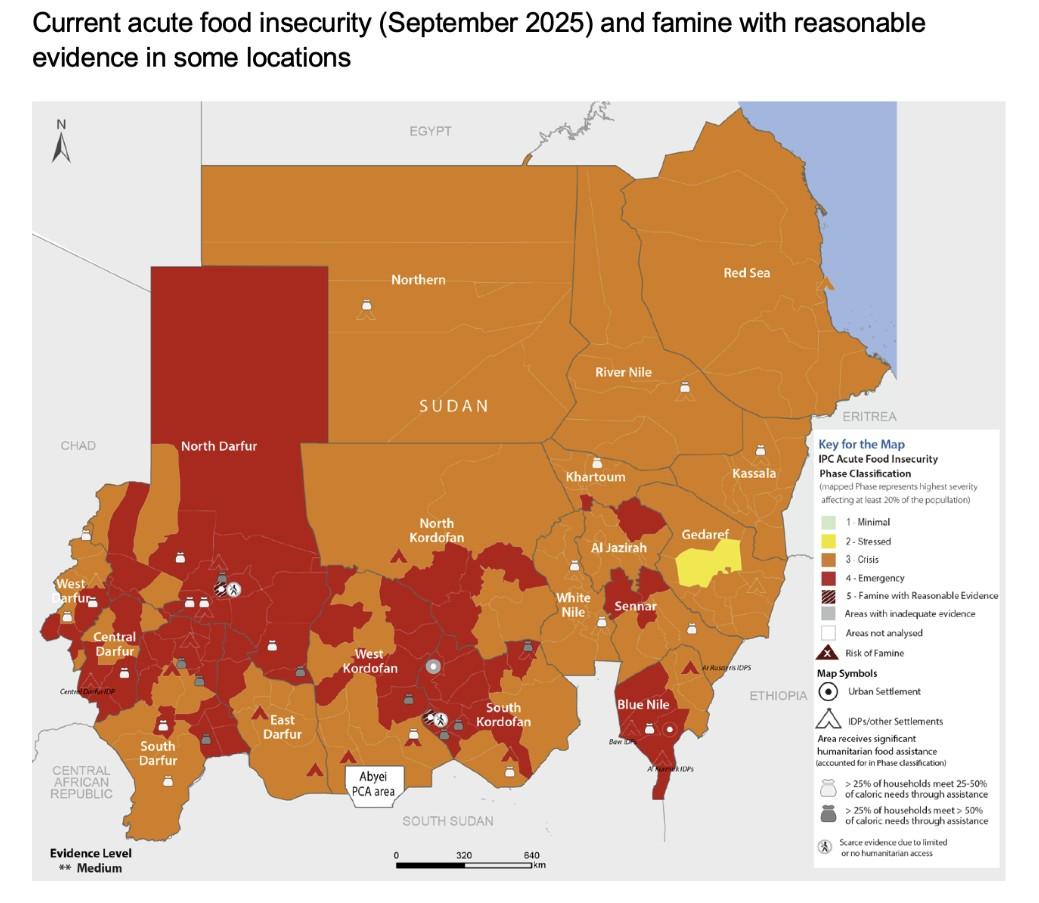IPC: Famine and food insecurity spread in Sudan as humanitarian crisis worsens

Sudan’s humanitarian emergency is worsening amid the country’s ongoing internal conflict, with devastating impacts on food security. The latest Integrated Food Security Phase Classification (IPC) analysis (November 3, 2025) shows that nearly half the population continues to confront high levels of acute food insecurity. Famine (IPC Phase 5) has been confirmed in the cities of El Fasher (North Darfur state) and Kadugli (South Kordofan state), with at least 20 additional localities at risk of famine if violence escalates or humanitarian access continues to be blocked.
This is the first formal confirmation of area-level Famine in Sudan during the conflict between the Sudanese Armed Forces (SAF) and the paramilitary Rapid Support Forces (RSF), which began in April 2023—although the 2024 IPC analysis had already identified significant populations in IPC Phase 5 (Catastrophe) across several states. This is a household-level classification defined as “experiencing an extreme lack of food, leading to alarmingly high acute malnutrition rates among children under five, significant excess mortality and an imminent risk of starvation.” The area-level classification is applied when at least 20% of households are experiencing famine conditions.
According to the IPC update, 21.2 million people are facing crisis levels of food insecurity (IPC Phase 3) or worse. Although a slight seasonal improvement is projected during the upcoming harvest months, the number of people in IPC Phase 3 or worse (IPC 3+) is projected to remain above 19 million throughout early and mid-2026.
Acute food insecurity: Current and projected conditions
As of September 2025 (current), an estimated 21.2 million people (about 44.6% of the analyzed population) were facing crisis-level food insecurity (IPC 3) or worse (Figures 1 and 2). Even during the October 2025-January 2026 harvest period, roughly 19.2 million people (40.5% of analyzed population) are projected to remain in IPC 3+, with a similar level expected for February-May 2026. These figures underscore the persistence of severe hardships across seasons.
Figure 1
Source: Authors compilation based on IPC (2025).
Figure 2
Source: Authors compilation based on IPC (2025).
The results highlight the fact that acute food insecurity remains widespread and persistent, driven by conflict-related disruptions to livelihoods, displacement, skyrocketing food prices, and the near-collapse of local markets. Even during the harvest months (typically the most food-secure time of the year), high levels of Emergency food insecurity (IPC 4) persist.
Figure 3 shows wide disparities in the severity of acute food insecurity across Sudan’s states in September 2025. Several, including North Darfur, South Darfur, Central Darfur, South Kordofan, Sennar, Blue Nile, and West Kordofan, have half or more of their populations in IPC Phase 3 or above. North Darfur has the highest share, with 71% of its population facing Crisis levels or worse.
The right panel of Figure 3 highlights the scale of needs in absolute terms. Al Jazirah, North Darfur, South Darfur, Khartoum, and North Kordofan contain the largest numbers of people in IPC Phases 3, 4, and 5. Emergency-level needs exceed 500,000 people in five states, and households in Catastrophe (IPC 5) are present in almost all conflict-affected areas. North Darfur and South Darfur have the highest concentrations of IPC Phase 5 populations. Overall, the figure shows that Sudan’s food crisis is widespread, severe, and at risk of further deterioration where conflict and access constraints persist.
Figure 3
Source: Authors compilation based on IPC (2025).
Famine confirmed in El Fasher and Kadugli
The Famine Review Committee (FRC) confirms that Famine (IPC Phase 5—reasonable evidence) is occurring in El Fasher (North Darfur) and Kadugli (South Kordofan) during the September-January period (Figure 4). Both towns have been under siege for months, with El Fasher falling to the RSF on October 26, and Kadugli still under attack. Residents are facing extreme hunger, market collapse, and near-total lack of access to humanitarian assistance.
- In El Fasher, households report going days without food, barely functioning markets, and food prices far beyond reach.
- In Kadugli, civilians rely on foraging and consuming non-food items (that are not intended for human consumption) as conflict and road blockages severely restrict access to supplies.
Collectively, these areas account for millions of people cut off from markets and humanitarian aid, representing the largest concentration of famine-risk localities globally in 2025. The inability to access these locations for extended periods has significantly worsened the humanitarian situation and sharply increased the risk of excess mortality.
Figure 4
Source: IPC (2025).
Compared with the 2024 IPC findings, which identified over 21 million people in IPC Phase 3+ and more than 150,000 in IPC Phase 5, the 2025 analysis reflects a further deterioration marked by the first confirmation of area-level Famine in El Fasher and Kadugli. Although national IPC 3+ numbers remain similar during harvest seasons, the geographic spread of famine-risk areas and the collapse of markets and humanitarian access distinguish the 2025 situation as substantially more severe.
Wider famine risks across Darfur and Kordofan
Beyond these two epicenters, at least 20 localities across Greater Darfur and Greater Kordofan are at risk of Famine under a plausible worst‑case scenario. These include:
- Kutum, Tawila, Melit, and rural El Fasher in North Darfur
- Nyala Janoub, Nyala Shimal, and Beliel in South Darfur
- Abu Karinka, Adila, and El Firdous in East Darfur
- Several rural and peri-urban areas in South and West Kordofan
These areas face a convergence of risks: Ongoing clashes, restrictions on trade routes, absence of functioning markets, limited humanitarian access, and large displaced populations.
Malnutrition surging to critical levels
The IPC Acute Malnutrition analysis shows extremely high levels of Global Acute Malnutrition (GAM):
- Over 60% of surveyed localities show GAM above the Emergency threshold of 15%.
- Several locations record GAM above 30%, surpassing the Famine threshold.
Women and children are disproportionately affected, especially in besieged areas where access to health and nutrition services has collapsed. The collapse of health and water, sanitation, and hygiene (WASH) services, particularly in besieged towns, has driven mortality risk sharply upward, compounding already severe food deficits.
Market collapse and price surges exacerbate food insecurity
Evidence from IFPRI’s Sudan Price, Availability and Quality Monitoring System (SPAMS) indicates that sustained increases in both food and fuel prices from February-September 2025 further constrained household access to food. Prices for key staples—including sorghum, millet, wheat, and wheat flour—rose by 10%-31% across monitored markets during this period, with sorghum recording the highest increase. These rising prices occurred alongside severe shortages in conflict-affected areas, especially where insecurity, road closures, or sieges have disrupted normal trade flows. Food quality has also deteriorated in many locations, particularly in remote areas reliant on long, informal supply chains.
Fuel prices rose at an even faster pace, compounding market stress. Regular diesel increased by 34% from February-September 2025, while parallel-market diesel rose by 20%. Regular petrol prices increased by 33%, and parallel-market petrol by 32%, reaching their highest levels in September. These increases have directly raised transport and distribution costs for traders, reinforcing food price inflation across the country and further eroding household purchasing power.
Table 1
These market pressures have sharply eroded purchasing power and worsened food access for millions of households, particularly displaced populations and those living in conflict-affected and hard-to-reach areas.
Key drivers
Three drivers underpin the crisis: Intensifying conflict and sieges that restrict civilian movement and access to markets and aid; macroeconomic collapse marked by inflation and currency depreciation; and highly constrained humanitarian access to populations in greatest need.
What must happen now?
Immediate de-escalation of the conflict and safe humanitarian access are essential to avert further loss of life and prevent the spread of famine. Priorities include protecting civilians and critical infrastructure; rapidly scaling food, nutrition, and health responses in famine-affected and high-risk areas; and facilitating commercial flows where feasible to restore market functioning and stabilize prices.
In addition, restoring large-scale data collection is critical to monitor health, nutrition, water access, and food security conditions. This requires sustained assessment access, especially in Greater Kordofan and Greater Darfur, with priority for El Fasher, Kadugli, Dilling, and surrounding localities.
Khalid Siddig is a Senior Research Fellow with IFPRI’s Development Strategies and Governance (DSG) Unit and Leader of IFPRI’s Sudan Strategy Support Program; Steven Were Omamo is DSG Director and Director for Africa. They are based in Nairobi, Kenya. Opinions are the authors’.




